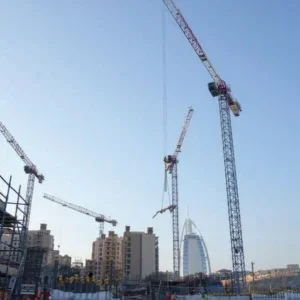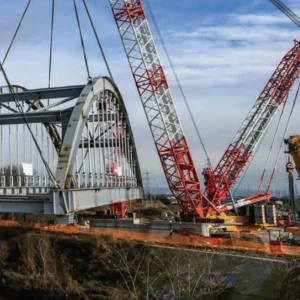Liebherr has developed a special mode for mobile cranes in the load-sensing range to reduce the cost of crane use whilst also reducing noise emissions. ECOmode minimises both fuel consumption and noise emissions when operating the crane superstructure.
It is hard for crane drivers to find the perfect engine speed for the required working speed. This can result in them mostly operating with a too high engine speed. This particularly applies to movements in which a speed well above idling speed does not produce any major addition. Examples of this include luffing down the boom or lowering the hoist unit.
In ‘ECOmode’ the crane driver sets the required working speed using the control lever. The LICCON2 control then calculates the perfect engine speed for it. This value is set on the crane engine using the engine control unit. The result of this dynamic adjustment of the engine speed compared to using a constant and therefore mostly excessive engine speed is to reduce fuel consumption and minimise noise emissions.
Liebherr said that ECOmode will be available in the future for all-terrain mobile cranes up to the 130t LTM 1130-5.1. A similar mode is already available on new large crane developments such as the LTM 1300-6.2 and LTM 1750. The manufacturer said that fuel savings could be up to 10% depending on the type of crane used. They also calculated that depending on the size of the crane ECOmode could save around 0.5 to 1l of diesel per hour. For 1,500 hours of service per annum that would mean a saving of up to 750 – 1,500 litres every year. ECOmode not only reduces costs for crane operators but also has a positive ecological effect since reducing fuel consumption results in approximately 2-4t less CO2 per crane per year.
The second new feature for the LICCON control system is the Variable Supporting Base. Uniquely among all terrain cranes, this allows operators to use their crane safely, regardless of outrigger position. The extension length and support force of every support is measured and the maximum lifting capacities for this situation are calculated by the crane control.
This means that for the first time, Liebherr says, it is possible to work safely with any support base and accidents caused by incorrect operation can be avoided both during the setup process and when handling loads. The Variable Supporting Base ensures higher lifting capacities and a larger working range, even with a maximum support base. The largest increases are made in the operating ranges directly above the supports. The Variable Supporting Base system also makes improvements over the 360° lifting capacity tables for hoisting to the front and rear.
When the crane is used with part ballast the increase in lifting capacity and the extension of the radius is even more pronounced with the new system than with full ballast. This means that there are less ballast transports needed for many crane jobs.
Liebherr’s LICCON work planner is supple-mented by the Variable Supporting Base system which means that jobs can be planned in advance with the new system by operations managers. But the LICCON control in the crane cab will also be supplemented with the work planner, which means that the planned hoists on the actual site can be simulated.






